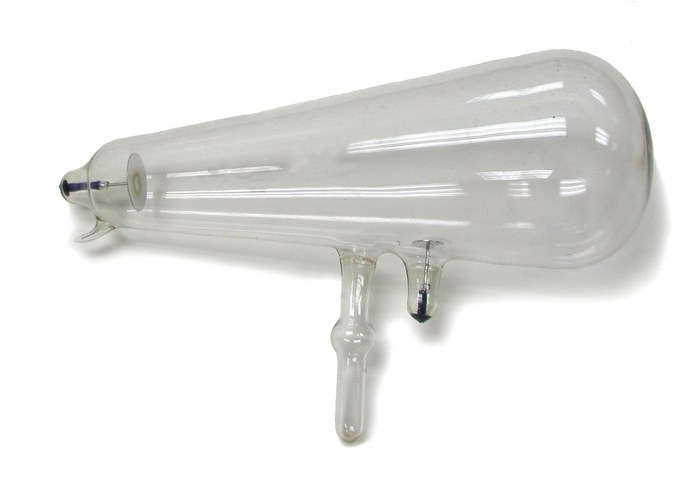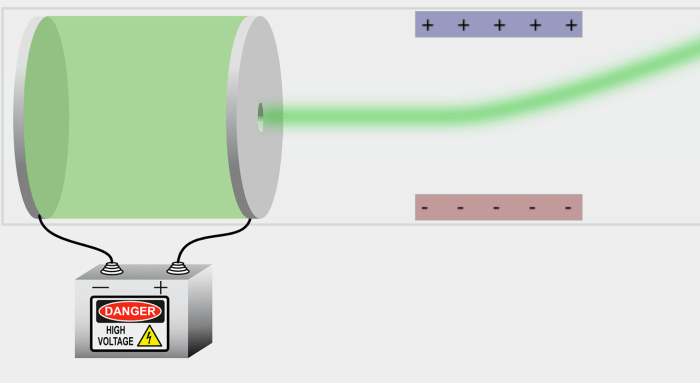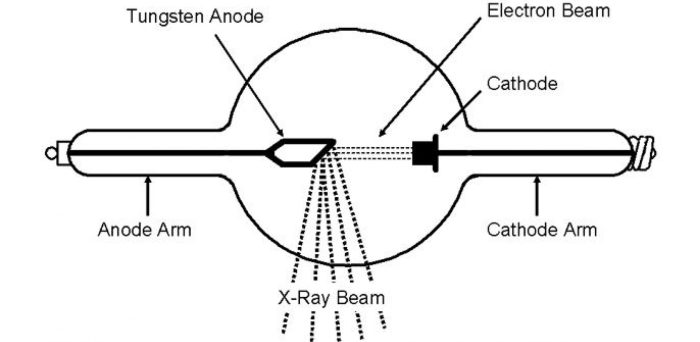Step into the realm of X-ray technology, where the Crookes tube and Coolidge tube reign supreme. These groundbreaking inventions revolutionized the medical and scientific worlds, and their legacy continues to shape our understanding of the unseen.
In this comprehensive guide, we’ll delve into the intricacies of these remarkable devices, exploring their history, principles, and applications. Join us on this enlightening journey as we unravel the fascinating story of Crookes tube and Coolidge tube.
Crookes Tube

The Crookes tube, invented by Sir William Crookes in 1875, is a pioneering vacuum tube that played a crucial role in the study of cathode rays and the development of X-rays.
It consists of a glass tube from which most of the air has been removed, creating a near vacuum. Inside the tube are two electrodes: a positively charged anode and a negatively charged cathode.
When a high voltage is applied across the electrodes, a stream of electrons is emitted from the cathode and travels towards the anode. These electrons collide with gas molecules remaining in the tube, causing them to emit light and produce X-rays.
The Crookes tube provided valuable insights into the nature of cathode rays and X-rays, paving the way for advancements in physics and medicine. However, it had several limitations and disadvantages.
Limitations and Disadvantages
- Low vacuum:The Crookes tube could not achieve a high vacuum, which limited the energy of the electron beam and the intensity of the X-rays produced.
- Inefficient cathode:The cathode in the Crookes tube was inefficient, meaning that only a small fraction of the electrons emitted from it reached the anode.
- X-ray production:The X-rays produced by the Crookes tube were weak and non-penetrating, limiting their usefulness for medical imaging.
Despite its limitations, the Crookes tube was a significant advancement in the field of vacuum tube technology and laid the groundwork for the development of more advanced X-ray tubes.
Coolidge Tube: Crookes Tube And Coolidge Tube

The Coolidge tube, an advancement over the Crookes tube, revolutionized the field of X-ray technology. Invented by William Coolidge in 1913, it marked a significant improvement in X-ray production and laid the foundation for modern X-ray tubes.
Structure and Operation
The Coolidge tube comprises a sealed glass envelope containing a high vacuum. Inside the tube, two electrodes are positioned at opposite ends: a heated cathode and a water-cooled anode. The cathode is made of tungsten, a high-melting-point metal that can withstand the intense heat generated during operation.
The anode is typically made of tungsten or molybdenum and is designed to absorb the electron beam and produce X-rays.
When a high voltage is applied between the electrodes, electrons are emitted from the heated cathode through thermionic emission. These electrons are accelerated towards the anode, where they collide with the anode material, releasing their energy in the form of X-rays.
Advantages and Improvements
The Coolidge tube offers several advantages over the Crookes tube:
- Stable and Continuous X-ray Production:Unlike the Crookes tube, which relied on gas discharge, the Coolidge tube operates in a high vacuum, ensuring a stable and continuous emission of X-rays.
- Adjustable Intensity and Penetration:The Coolidge tube allows for precise control of the X-ray intensity and penetration by varying the cathode temperature and the applied voltage.
- Reduced Gas Contamination:The high vacuum in the Coolidge tube eliminates gas contamination, resulting in sharper and clearer X-ray images.
- Enhanced Heat Dissipation:The water-cooled anode effectively dissipates heat generated by the electron bombardment, preventing damage to the anode and extending the tube’s lifespan.
Comparison of Crookes Tube and Coolidge Tube

The Crookes tube and Coolidge tube are two types of X-ray tubes that played significant roles in the development of X-ray technology. Both tubes produce X-rays by bombarding a metal target with a beam of electrons, but they differ in their design and performance.
Key Differences
- Cathode design:The Crookes tube uses a cold cathode, while the Coolidge tube uses a hot cathode.
- Vacuum level:The Crookes tube operates at a lower vacuum than the Coolidge tube.
- X-ray intensity:The Coolidge tube produces a more intense and stable beam of X-rays than the Crookes tube.
Historical Significance, Crookes tube and coolidge tube
The Crookes tube was invented by Sir William Crookes in 1875. It was the first device to produce X-rays, and it played a crucial role in the early development of X-ray technology. The Coolidge tube was invented by William Coolidge in 1913. It was a major improvement over the Crookes tube, and it quickly became the standard X-ray tube used in medical and industrial applications.
The Crookes tube and Coolidge tube are two types of vacuum tubes used to generate X-rays. Crookes tubes, developed by Sir William Crookes, use a high voltage to accelerate electrons into a metal target, producing X-rays. Coolidge tubes, developed by William Coolidge, use a heated cathode to produce electrons, which are then accelerated into a metal target to generate X-rays.
If you’re looking for more information about the phrase be situated next to crossword , check out the link provided. The Crookes tube and Coolidge tube are both used in a variety of applications, including medical imaging and industrial radiography.
Applications
The Crookes tube was primarily used for research purposes, while the Coolidge tube is widely used in medical and industrial applications, such as:
- Medical imaging (e.g., X-rays, CT scans)
- Industrial radiography (e.g., inspecting welds, castings)
- Security screening (e.g., airport baggage scanners)
Applications of Crookes Tube and Coolidge Tube

The Crookes tube and Coolidge tube have found widespread applications in various fields, including science, medicine, and industry. Their ability to generate X-rays and electron beams has revolutionized our understanding of the physical world and has led to significant advancements in medical diagnostics and industrial processes.
Medical Imaging
One of the most important applications of the Crookes tube and Coolidge tube is in medical imaging. X-rays, generated by these tubes, allow doctors to visualize the internal structures of the body, such as bones, organs, and blood vessels. This information is crucial for diagnosing and treating a wide range of medical conditions, including fractures, tumors, and infections.
- Radiography:This technique uses X-rays to create images of the bones and other dense structures in the body.
- Fluoroscopy:This technique involves using a continuous beam of X-rays to visualize moving structures, such as the heart and lungs.
- Computed tomography (CT):This technique combines multiple X-ray images taken from different angles to create cross-sectional images of the body.
Research
Crookes tubes and Coolidge tubes have also played a vital role in scientific research. The electron beams generated by these tubes are used to study the structure of atoms and molecules, as well as the properties of materials. They have also been used to develop new technologies, such as electron microscopy and particle accelerators.
- X-ray crystallography:This technique uses X-rays to determine the crystal structure of materials.
- Electron microscopy:This technique uses electron beams to magnify objects at extremely high resolutions.
- Particle accelerators:These devices use electron beams to accelerate charged particles to high energies, which are then used to study the fundamental particles of matter.
Industry
Crookes tubes and Coolidge tubes have also found applications in various industrial processes. X-rays are used to inspect welds, castings, and other materials for defects. Electron beams are used for welding, cutting, and surface modification of materials.
- Industrial radiography:This technique uses X-rays to inspect welds, castings, and other materials for defects.
- Electron beam welding:This technique uses electron beams to weld materials together.
- Electron beam cutting:This technique uses electron beams to cut materials.
Potential Future Applications
The Crookes tube and Coolidge tube continue to be important tools in science, medicine, and industry. As technology advances, new applications for these tubes are constantly being discovered. Some potential future applications include:
- Cancer treatment:Electron beams are being investigated as a potential treatment for cancer.
- Space exploration:X-rays and electron beams are being used to study the composition of planets and moons.
- Security screening:X-rays are used in security screening to detect hidden objects.
FAQ Corner
What is the primary purpose of a Crookes tube?
The Crookes tube generates X-rays, which are used for various applications in medicine, scientific research, and industrial settings.
How does a Coolidge tube differ from a Crookes tube?
The Coolidge tube features a heated cathode and a water-cooled anode, resulting in higher X-ray intensity and longer tube life compared to the Crookes tube.
What are some common applications of Crookes tubes and Coolidge tubes?
These tubes are widely used in medical imaging, such as X-ray radiography and fluoroscopy, as well as in scientific research and industrial applications like material analysis and non-destructive testing.